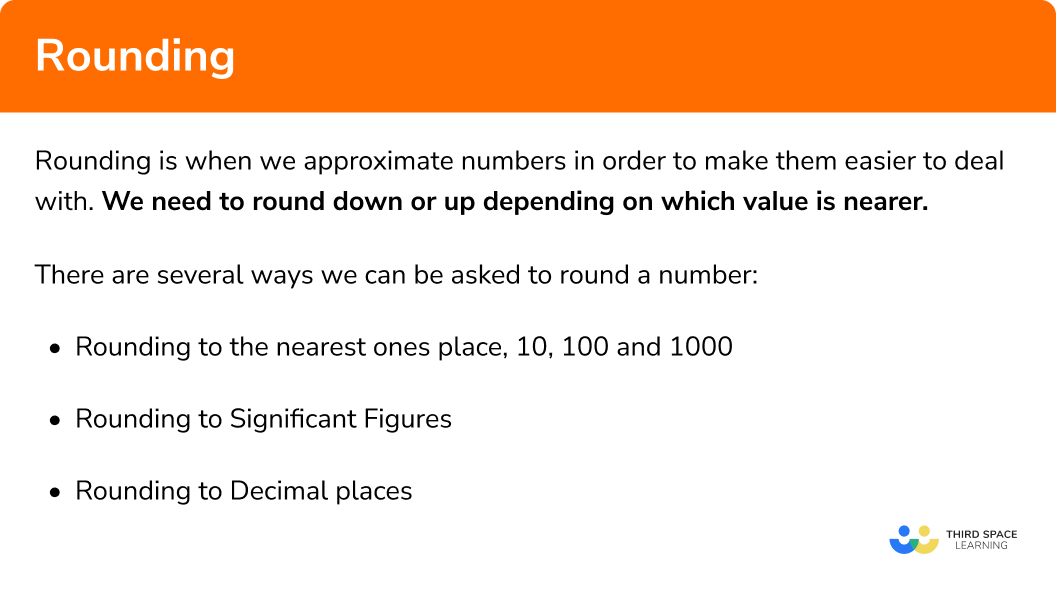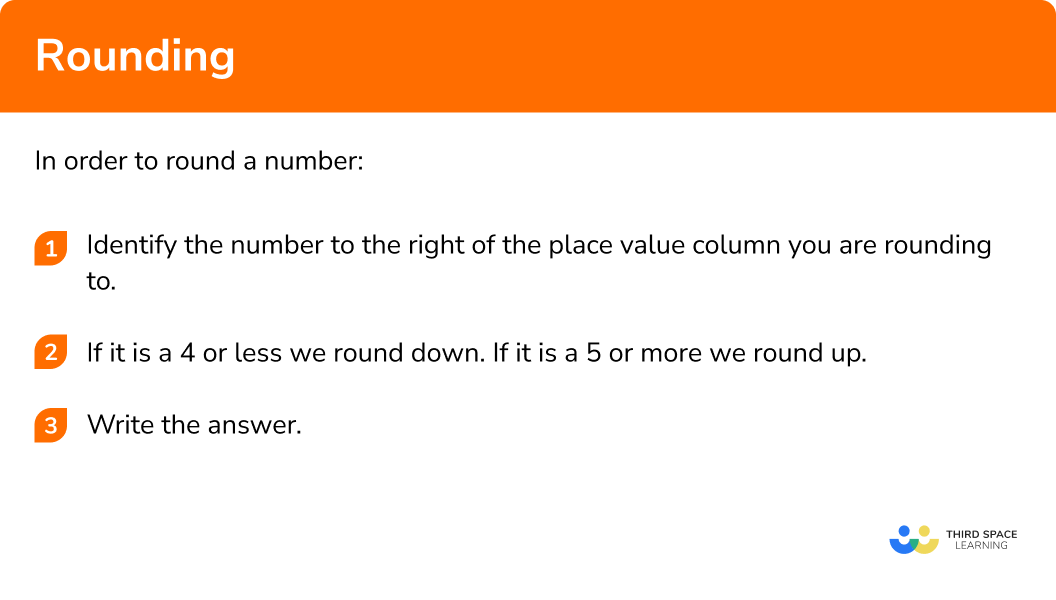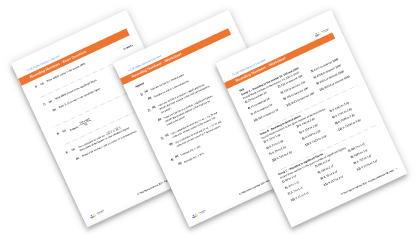GCSE Tutoring Programme
"Our chosen students improved 1.19 of a grade on average - 0.45 more than those who didn't have the tutoring."
In order to access this I need to be confident with:
Place valueThis topic is relevant for:

Rounding Numbers
Here we will learn about rounding including how to round a number to the nearest
There are also rounding worksheets based on Edexcel, AQA and OCR exam questions, along with further guidance on where to go next if you’re still stuck.
What is rounding?
Rounding is when we approximate numbers in order to make them easier to deal with. We need to round down or up depending on which value is nearer.
There are several ways we can be asked to round a number.
E.g.
- Rounding to the nearest ones place,
10, 100 and1000 1478.47 is1478 rounded to the nearest ones place1478.47 is1480 rounded to the nearest10 1478.47 is1500 rounded to the nearest100 1478.47 is1000 rounded to the nearest1000 - Rounding to significant figures
1478.47 is1000 rounded to1 significant figure1478.47 is1500 rounded to2 significant figures1478.47 is1480 rounded to3 significant figures - Rounding to decimal places
1478.2735 is1478.3 rounded to1 decimal place (the nearest tenth)1478.2735 is1478.27 rounded to2 decimal places (the nearest hundredth)1478.2735 is1478.274 rounded to3 decimal places (the nearest thousandth)
Truncating a number and estimation are also linked with rounding:
- Truncation is cutting a number off at a certain value with no need to round up.
- Estimation is using the approximated numbers for a calculation; we do not use the exact numbers.
What is rounding?

How to round numbers
In order to round a number:
- Identify the number to the right of the place value column you are rounding to
- If it is a 4 or less we round down, if it is a 5 or more we round up
- Write the answer.
Explain how to round a number in 3 steps


Rounding numbers worksheet

Get your free rounding numbers worksheet of 20+ questions and answers. Includes reasoning and applied questions.
DOWNLOAD FREE
Rounding numbers worksheet

Get your free rounding numbers worksheet of 20+ questions and answers. Includes reasoning and applied questions.
DOWNLOAD FREERounding numbers examples
Example 1: rounding to the nearest 10, 100 and 1000
Round
- Identify the number to the right of the place value column you are rounding to
We are rounding to the nearest
This is a 2.
2 If it is a 4 or less we round down, if it is a 5 or more we round up
It is a
3 Write the answer.
Step-by-step guide: Rounding to the nearest 10, 100 and 1000
Example 2: rounding to decimal places
Round
Identify the number to the right of the place value column you are rounding to
We are rounding to
This is a 6
If it is a 4 or less we round down, if it is a 5 or more we round up
Write the answer.
Step-by-step guide: Decimal places
Example 3: rounding to decimal places
Round
Identify the number to the right of the place value column you are rounding to
We are rounding to the nearest whole number so we identify the number to the right of the 5 in the ones column.
This is a 6.
If it is a 4 or less we round down, if it is a 5 or more we round up
Write the answer.
Step-by-step guide: Rounding decimals
Example 4: rounding to significant figures
Round
Identify the number to the right of the place value column you are rounding to
We are rounding to
This is a 5
If it is a 4 or less we round down, if it is a 5 or more we round up
As the digit is a
Write the answer.
Step-by-step guide: Significant figures
Example 5: rounding to significant figures
Round
Identify the number to the right of the place value column you are rounding to
We are rounding to
This is an 8.
If it is a 4 or less we round down, if it is a 5 or more we round up
Write the answer.
Step-by-step guide: Upper and lower bounds
See also: Place value
Example 6: truncation
Truncate
Identify the number in the place value column you are truncating to
We are truncating to
This is an 8.
Round the number to what is asked for. Round down or up as required.
As we have been asked to truncate the number we can miss off all of the digits after the second decimal place.
Write the answer.
Step-by-step guide: Truncation
See also: Error intervals
Example 7: estimation
Estimate the following calculation:
Identify the number to the right of the place value column you are rounding to
As we are estimating we need to round each number to
In
This is an 8.
In
This is a 4.
If it is a 4 or less we round down, if it is a 5 or more we round up
8 is more than 5 so we round 287.1 up to 300.
4 is less than 5 so we round 14.7 down to 10.
Write the answer.
The estimated calculation is
The estimated answer is is
Step-by-step guide: Estimation
Common misconceptions
- Remember to put zero in as a place holder before the decimal point
E.g.
When we round
NOT 27
- Sometimes we need a zero in as a place holder with decimal numbers
E.g.
When we round
- Estimation of numbers within square roots
If your estimation involves a square root symbol, round those numbers to the nearest square number.
E.g.
Rounding practice questions
1. Round 193 to the nearest 100 .




We are rounding to the nearest 100 . Identifying the 9 in the tens column indicates we need to round up.
2. Round 13.782 to 2 decimal places.




We are rounding to 2 decimal places. The 2 in the thousandths column indicates that we should round down.
3. Round 5692 to 2 significant figures.




We are rounding to 2 significant figures. The 9 in the tens column indicates we round up. We need to have zeros in the tens and ones columns as place holders.
4. Round 0.0365 to 2 significant figures.




We are rounding to 2 significant figures. The second significant figure is 6 .
The 5 in the ten thousandths column indicates we round the 6 up.
5. Truncate 78 to the nearest 10 .




We locate the digit in the tens column and truncate to this degree of accuracy, replacing the digit in the ones column with a zero.
6. Estimate 341 × 27 .




By first rounding each number to one significant figure, the calculation becomes
300\times30 = 9000
Rounding GCSE Questions
1. Write 78 348 correct to the nearest 1000 .
(1 Mark)
78 000
(1)
2. (a) Write 8400 correct to one significant figure.
(b) Write 3.51 correct to one significant figure.
(2 Marks)
(a)
8000
(1)
(b)
4
(1)
3. Work out an estimate for
\frac{572\times213}{36} .
(2 Marks)
For rounding one original number to 1 significant figure 600 or 200 or 40
\frac{600\times200}{40}
(1)
For the calculation involving all three correctly rounded numbers.
(1)
for the correct answer
= 3000
(1)
4. (a) Use your calculator to work out
\frac{65.4+49.3}{23.4-15.8}
Write down all the figures on your display.
(b) Write your answer to part (a) to 1 decimal place.
(2 Marks)
(a) 15.092105…
(1)
(b) 15.1 (1.d.p)
(1)
Learning checklist
You have now learned how to:
-
Round numbers to a number of decimal places
-
Round numbers to a number of significant figures
-
Use approximation through rounding to estimate answers
The next lessons are
Still stuck?
Prepare your KS4 students for maths GCSEs success with Third Space Learning. Weekly online one to one GCSE maths revision lessons delivered by expert maths tutors.

Find out more about our GCSE maths tuition programme.